Genetic history of indigenous peoples of the Americas
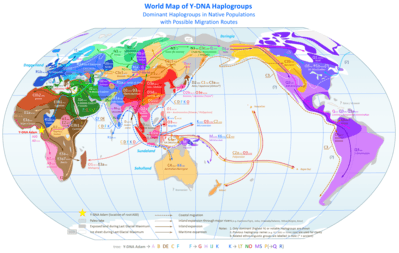
The genetic history of Indigenous peoples of the Americas (also named Amerindians or Amerinds in physical anthropology) is divided into two sharply distinct episodes: the initial peopling of the Americas during about 20,000 to 14,000 years ago (20–14 kya), and European contact, after about 500 years ago.[1][2] The former is the determinant factor for the number of genetic lineages, zygosity mutations and founding haplotypes present in today's Indigenous Amerindian populations.[3]
Most Amerindians groups are derived from a basal Ancestral lineage, which formed in Siberia prior to the Last Glacial Maximum, between about 36,000 and 25,000 years ago, from a combination of early East Asian and Ancient North Eurasian ancestry and which dispersed throughout the Americas after about 16,000 years ago (an exception are the Na Dene and Eskimo–Aleut speaking groups, which are partially derived from Siberian populations which entered the Americas at a later time).[4]
In the early 2000s, archaeogenetics was primarily based on Human Y-chromosome DNA haplogroups and Human mitochondrial DNA haplogroups.[5] Autosomal "atDNA" markers are also used, but differ from mtDNA or Y-DNA in that they overlap significantly.[6]
Analysis of genetics among Amerindian and Siberian populations have been used to argue for early isolation of founding populations on Beringia[7] and for later, more rapid migration from Siberia through Beringia into the New World.[8] The microsatellite diversity and distributions of the Y lineage specific to South America indicates that certain Amerindian populations have been isolated since the initial colonization of the region.[9] The Na-Dené, Inuit and Indigenous Alaskan populations exhibit Haplogroup Q-M242; however, they are distinct from other indigenous Amerindians with various mtDNA and atDNA mutations.[10][11][12] This suggests that the peoples who first settled in the northern extremes of North America and Greenland derived from later migrant populations than those who penetrated farther south in the Americas.[13][14] Linguists and biologists have reached a similar conclusion based on analysis of Amerindian language groups and ABO blood group system distributions.[15][16][17]
Autosomal DNA
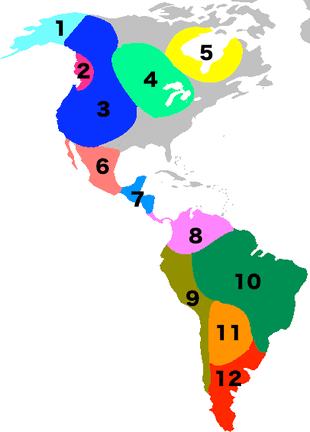
Genetic diversity and population structure in the American landmass is also measured using autosomal (atDNA) micro-satellite markers genotyped; sampled from North, Central, and South America and analyzed against similar data available from other indigenous populations worldwide.[18][19] The Amerindian populations show a lower genetic diversity than populations from other continental regions.[19] Observed is a decreasing genetic diversity as geographic distance from the Bering Strait occurs, as well as a decreasing genetic similarity to Siberian populations from Alaska (the genetic entry point).[18][19] Also observed is evidence of a higher level of diversity and lower level of population structure in western South America compared to eastern South America.[18][19] There is a relative lack of differentiation between Mesoamerican and Andean populations, a scenario that implies that coastal routes were easier for migrating peoples (more genetic contributors) to traverse in comparison with inland routes.[18]
The over-all pattern that is emerging suggests that the Americas were colonized by a small number of individuals (effective size of about 70), which grew by a factor of 10 over 800 – 1000 years.[20][21] The data also shows that there have been genetic exchanges between Asia, the Arctic, and Greenland since the initial peopling of the Americas.[21][22]
Moreno-Mayar et al. (2018) have identified a basal Ancestral Native American (ANA) lineage. This lineage formed by admixture of early East Asian and Ancient North Eurasian lineages prior to the Last Glacial Maximum, ca. 36–25 kya. Basal ANA diverged into an "Ancient Beringian" (AB) lineage at ca. 20 kya. The non-AB lineage further diverged into "Northern Native American" (NNA) and "Southern Native American" (SNA) lineages between about 17.5 and 14.6 kya. Most pre-Columbian lineages are derived from NNA and SNA, except for the American Arctic, where there is evidence of later (after 10kya) admixture from Paleo-Siberian lineages.[4]
In 2014, the autosomal DNA of a 12,500+-year-old infant from Montana was sequenced.[23] The DNA was taken from a skeleton referred to as Anzick-1, found in close association with several Clovis artifacts. Comparisons showed strong affinities with DNA from Siberian sites, and virtually ruled out that particular individual had any close affinity with European sources (the "Solutrean hypothesis"). The DNA also showed strong affinities with all existing Amerindian populations, which indicated that all of them derive from an ancient population that lived in or near Siberia, the Upper Palaeolithic Mal'ta population.[24]
According to an autosomal genetic study from 2012,[25] Native Americans descend of at least three main migrant waves from East Asia. Most of it is traced back to a single ancestral population, called 'First Americans'. However, those who speak Inuit languages from the Arctic inherited almost half of their ancestry from a second East Asian migrant wave. And those who speak Na-dene, on the other hand, inherited a tenth of their ancestry from a third migrant wave. The initial settling of the Americas was followed by a rapid expansion southwards, by the coast, with little gene flow later, especially in South America. One exception to this are the Chibcha speakers, whose ancestry comes from both North and South America. [25]
Linguistic studies have backed up genetic studies, with ancient patterns having been found between the languages spoken in Siberia and those spoken in the Americas.[26]
Two 2015 autosomal DNA genetic studies confirmed the Siberian origins of the Natives of the Americas. However an ancient signal of shared ancestry with Australasians (Natives of Australia, Melanesia and the Andaman Islands) was detected among the Natives of the Amazon region. The migration coming out of Siberia would have happened 23,000 years ago.[27][28][29]
Paternal lineages
A "Central Siberian" origin has been postulated for the paternal lineage of the source populations of the original migration into the Americas.[30]
Membership in haplogroups Q and C3b implies indigenous American patrilineal descent.[31]
Haplogroup Q
Q-M242 (mutational name) is the defining (SNP) of Haplogroup Q (Y-DNA) (phylogenetic name). Within the Q clade, there are 14 haplogroups marked by 17 SNPs.2009[32][33] In Eurasia, haplogroup Q is found among indigenous Siberian populations, such as the modern Chukchi and Koryak peoples. In particular, two groups exhibit large concentrations of the Q-M242 mutation, the Ket (93.8%) and the Selkup (66.4%) peoples.[34] The Ket are thought to be the only survivors of ancient wanderers living in Siberia.[20] Their population size is very small; there are fewer than 1,500 Ket in Russia.2002[20] The Selkup have a slightly larger population size than the Ket, with approximately 4,250 individuals.[35]
Starting the Paleo-Indians period, a migration to the Americas across the Bering Strait (Beringia) by a small population carrying the Q-M242 mutation took place.[11] A member of this initial population underwent a mutation, which defines its descendant population, known by the Q-M3 (SNP) mutation.[36] These descendants migrated all over the Americas.[32]
Haplogroup Q-M3 is defined by the presence of the rs3894 (M3) (SNP).[1][20][37] The Q-M3 mutation is roughly 15,000 years old as that is when the initial migration of Paleo-Indians into the Americas occurred.[38][39] Q-M3 is the predominant haplotype in the Americas, at a rate of 83% in South American populations,[9] 50% in the Na-Dené populations, and in North American Eskimo-Aleut populations at about 46%.[34] With minimal back-migration of Q-M3 in Eurasia, the mutation likely evolved in east-Beringia, or more specifically the Seward Peninsula or western Alaskan interior. The Beringia land mass began submerging, cutting off land routes.[34][40][18]
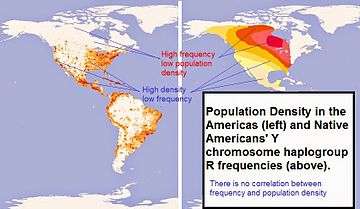
Since the discovery of Q-M3, several subclades of M3-bearing populations have been discovered. An example is in South America, where some populations have a high prevalence of (SNP) M19 which defines subclade Q-M19.[9] M19 has been detected in (59%) of Amazonian Ticuna men and in (10%) of Wayuu men.[9] Subclade M19 appears to be unique to South American Indigenous peoples, arising 5,000 to 10,000 years ago.[9] This suggests that population isolation and perhaps even the establishment of tribal groups began soon after migration into the South American areas.[20][42] Other American subclades include Q-L54, Q-Z780, Q-MEH2, Q-SA01, and Q-M346 lineages. In Canada, two other lineages have been found. These are Q-P89.1 and Q-NWT01.
The principal-component analysis suggests a close genetic relatedness between some North American Amerindians (the Chipewyan and the Cheyenne) and certain populations of central/southern Siberia (particularly the Kets, Yakuts, Selkups and Altays), at the resolution of major Y-chromosome haplogroups.[9] This pattern agrees with the distribution of mtDNA haplogroup X, which is found in North America, is absent from eastern Siberia, but is present in the Altais of southern central Siberia. Similarly, the Asian populations closest to Native Americans are characterized by a predominance of lineage P-M45* and low frequencies of C-RPS4Y.[9]
Haplogroup R1
Haplogroup R1 (Y-DNA) (specifically R1b) is the second most predominant Y haplotype found among indigenous Amerindians after Q (Y-DNA).[41] The distribution of R1 is believed by some to be associated with the re-settlement of Eurasia following the last glacial maximum. One theory put forth is that R1 entered the Americas with the initial founding population,[9] suggesting prehistoric Amerindian immigration from Asia through Beringia[43][44] and correlating mostly with the frequency of haplogroups Q-M3 and P-M45*.[9] A second theory is that it was introduced during European colonization.[41] R1 is very common throughout all of Eurasia except East Asia and Southeast Asia. R1 (M173) is found predominantly in North American groups like the Ojibwe (50-79%), Seminole (50%), Sioux (50%), Cherokee (47%), Dogrib (40%) and Tohono O'odham (Papago) (38%).[41]
A study of Raghavan et al. 2013 found that autosomal evidence indicates that skeletal remain of a south-central Siberian child carrying R* y-dna (Mal'ta boy-1) "is basal to modern-day western Eurasians and genetically closely related to modern-day Amerindians, with no close affinity to east Asians. This suggests that populations related to contemporary western Eurasians had a more north-easterly distribution 24,000 years ago than commonly thought." Sequencing of another south-central Siberian (Afontova Gora-2) revealed that "western Eurasian genetic signatures in modern-day Amerindians derive not only from post-Columbian admixture, as commonly thought, but also from a mixed ancestry of the First Americans."[44] It is further theorized if "Mal'ta might be a missing link, a representative of the Asian population that admixed both into Europeans and Native Americans."[45]
Haplogroup C-P39
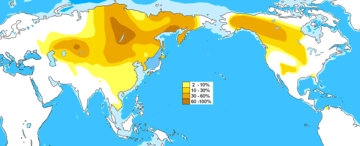
Haplogroup C-M217 is mainly found in indigenous Siberians, Mongolians and Kazakhs. Haplogroup C-M217 is the most widespread and frequently occurring branch of the greater (Y-DNA) haplogroup C-M130. Haplogroup C-M217 descendant C-P39 is commonly found in today's Na-Dené speakers, with the highest frequency found among the Athabaskans at 42%.[11] This distinct and isolated branch C-P39 includes almost all the Haplogroup C-M217 Y-chromosomes found among all indigenous peoples of the Americas.[46] The Na-Dené groups are also unusual among indigenous peoples of the Americas in having a relatively high frequency of Q-M242 (25%).[34]
Some researchers feel that this may indicate that the Na-Dené migration occurred from the Russian Far East after the initial Paleo-Indian colonization, but prior to modern Inuit, Inupiat and Yupik expansions.[11][10][47]
Maternal lineages
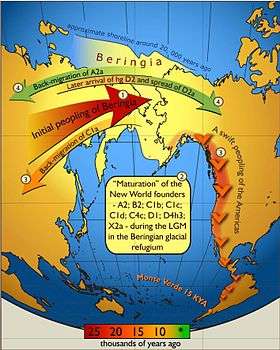
The common occurrence of the mtDNA Haplogroups A, B, C, and D among eastern Asian and Amerindian populations has long been recognized, along with the presence of Haplogroup X.[48] As a whole, the greatest frequency of the four Amerindian associated haplogroups occurs in the Altai-Baikal region of southern Siberia.[49] Some subclades of C and D closer to the Amerindian subclades occur among Mongolian, Amur, Japanese, Korean, and Ainu populations.[48][50]
When studying human mitochondrial DNA (mtDNA) haplogroups, the results indicated until recently that Indigenous Amerindian haplogroups, including haplogroup X, are part of a single founding East Asian population. It also indicates that the distribution of mtDNA haplogroups and the levels of sequence divergence among linguistically similar groups were the result of multiple preceding migrations from Bering Straits populations.[51][52] All indigenous Amerindian mtDNA can be traced back to five haplogroups, A, B, C, D and X.[53][54] More specifically, indigenous Amerindian mtDNA belongs to sub-haplogroups A2, B2, C1, D1, and X2a (with minor groups C4c, D2, D3, and D4h3).[7][52] This suggests that 95% of Indigenous Amerindian mtDNA is descended from a minimal genetic founding female population, comprising sub-haplogroups A2, B2, C1b, C1c, C1d, and D1.[53] The remaining 5% is composed of the X2a, D2, D3, C4, and D4h3 sub-haplogroups.[52][53]
X is one of the five mtDNA haplogroups found in Indigenous Amerindian peoples. Unlike the four main American mtDNA haplogroups (A, B, C and D), X is not at all strongly associated with east Asia.[20] Haplogroup X genetic sequences diverged about 20,000 to 30,000 years ago to give two sub-groups, X1 and X2. X2's subclade X2a occurs only at a frequency of about 3% for the total current indigenous population of the Americas.[20] However, X2a is a major mtDNA subclade in North America; among the Algonquian peoples, it comprises up to 25% of mtDNA types.[1][55] It is also present in lower percentages to the west and south of this area — among the Sioux (15%), the Nuu-chah-nulth (11%–13%), the Navajo (7%), and the Yakama (5%).[56] Haplogroup X is more strongly present in the Near East, the Caucasus, and Mediterranean Europe.[56] The predominant theory for sub-haplogroup X2a's appearance in North America is migration along with A, B, C, and D mtDNA groups, from a source in the Altai Mountains of central Asia.[57][58][59][60]
Sequencing of the mitochondrial genome from Paleo-Eskimo remains (3,500 years old) are distinct from modern Amerindians, falling within sub-haplogroup D2a1, a group observed among today's Aleutian Islanders, the Aleut and Siberian Yupik populations.[61] This suggests that the colonizers of the far north, and subsequently Greenland, originated from later coastal populations.[61] Then a genetic exchange in the northern extremes introduced by the Thule people (proto-Inuit) approximately 800–1,000 years ago began.[12][62] These final Pre-Columbian migrants introduced haplogroups A2a and A2b to the existing Paleo-Eskimo populations of Canada and Greenland, culminating in the modern Inuit.[12][62]
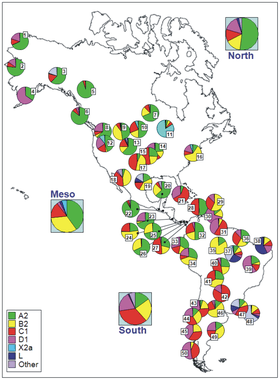
A 2013 study in Nature reported that DNA found in the 24,000-year-old remains of a young boy from the archaeological Mal'ta-Buret' culture suggest that up to one-third of indigenous Americans' ancestry can be traced back to western Eurasians, who may have "had a more north-easterly distribution 24,000 years ago than commonly thought"[44] "We estimate that 14 to 38 percent of Amerindian ancestry may originate through gene flow from this ancient population," the authors wrote. Professor Kelly Graf said,
"Our findings are significant at two levels. First, it shows that Upper Paleolithic Siberians came from a cosmopolitan population of early modern humans that spread out of Africa to Europe and Central and South Asia. Second, Paleoindian skeletons like Buhl Woman with phenotypic traits atypical of modern-day indigenous Americans can be explained as having a direct historical connection to Upper Paleolithic Siberia."[63]
A route through Beringia is seen as more likely than the Solutrean hypothesis.[64] An abstract in a 2012 issue of the "American Journal of Physical Anthropology" states that "The similarities in ages and geographical distributions for C4c and the previously analyzed X2a lineage provide support to the scenario of a dual origin for Paleo-Indians. Taking into account that C4c is deeply rooted in the Asian portion of the mtDNA phylogeny and is indubitably of Asian origin, the finding that C4c and X2a are characterized by parallel genetic histories definitively dismisses the controversial hypothesis of an Atlantic glacial entry route into North America."[65]
Another study, also focused on the mtDNA (that which is inherited through only the maternal line),[7] revealed that the indigenous people of the Americas have their maternal ancestry traced back to a few founding lineages from East Asia, which would have arrived via the Bering strait. According to this study, it is probable that the ancestors of the Native Americans would have remained for a time in the region of the Bering Strait, after which there would have been a rapid movement of settling of the Americas, taking the founding lineages to South America.
According to a 2016 study, focused on mtDNA lineages, "a small population entered the Americas via a coastal route around 16.0 ka, following previous isolation in eastern Beringia for ~2.4 to 9 thousand years after separation from eastern Siberian populations. Following a rapid movement throughout the Americas, limited gene flow in South America resulted in a marked phylogeographic structure of populations, which persisted through time. All of the ancient mitochondrial lineages detected in this study were absent from modern data sets, suggesting a high extinction rate. To investigate this further, we applied a novel principal components multiple logistic regression test to Bayesian serial coalescent simulations. The analysis supported a scenario in which European colonization caused a substantial loss of pre-Columbian lineages".[66]
Paleoamericans
There is genetic evidence for an early wave of migration to the Americas. It is uncertain whether this "Paleoamerican" (also "Paleoamerind", not to confused with the term Paleo-Indian used of the early phase of Amerinds proper) migration took place in the early Holocene, thus only shortly predating the main Amerind peopling of the Americas, or whether it may have reached the Americas substantially earlier, before the Last Glacial Maximum.[67] Genetic evidence for "Paleoamerinds" consists of the presence of apparent admixture of archaic Sundadont lineages to the remote populations in the South American rain forest, and in the genetics and cranial morphology of Patagonians-Fuegians.[68] Nomatto et al. (2009) proposed into Beringia occurred between 40k and 30k cal years BP, with a pre-LGM migration into the Americas followed by isolation of the northern population following closure of the ice-free corridor.[69] Evidence of people from Australia and Melanesia admixture in Amazonian populations was found by Skoglund and Reich (2016).[70]
Archaeological evidence for pre-LGM human presence in the Americas was first presented in the 1970s.[71][72] notably the "Luzia Woman" skull found in Brazil and the Monte Verde site in Chile, both discovered in 1975.[73] Other notable sites of early human inhabitation found in North America include Paisley Caves, Oregon and Bluefish Caves, Canada.[74][75]
Old World genetic admixture
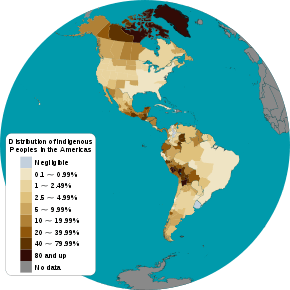
Substantial racial admixture has taken place during and since the European colonization of the Americas.[76][77]
South and Central America
In Latin America in particular, significant racial admixture took place between the indigenous Amerind population, the European-descended colonial population, and the Sub-Saharan African populations imported as slaves. From about 1700, a Latin American terminology developed to refer to the various combinations of mixed racial descent produced by this.[78]
Many individuals who self-identify as one race exhibit genetic evidence of a multiracial ancestry.[79] The European conquest of South and Central America, beginning in the late 15th century, was initially executed by male soldiers and sailors from the Iberian Peninsula (Spain and Portugal).[80] The new soldier-settlers fathered children with Amerindian women and later with African slaves.[81] These mixed-race children were generally identified by the Spanish colonist and Portuguese colonist as "Castas".[82]
North America
The North American fur trade during the 16th century brought many more European men, from France, Ireland, and Great Britain, who took North Amerindian women as wives.[83] Their children became known as "Métis" or "Bois-Brûlés" by the French colonists and "mixed-bloods", "half-breeds" or "country-born" by the English colonists and Scottish colonists.[84]
Native Americans in the United States are more likely than any other racial group to practice racial exogamy, resulting in an ever-declining proportion of indigenous ancestry among those who claim a Native American identity.[85] In the United States 2010 census, nearly 3 million people indicated that their race was Native American (including Alaska Native).[86] This is based on self-identification, and there are no formal defining criteria for this designation. Especially numerous was the self-identification of Cherokee ethnic origin,[87] a phenomenon dubbed the "Cherokee Syndrome".[88] The context is the cultivation of an opportunistic ethnic identity related to the perceived prestige associated with Native American ancestry.[89] Native American identity in the Eastern United States is mostly detached from genetic descent, and embraced by people of predominantly European ancestry.[89][90] Some tribes have adopted criteria of racial purity, usually through a Certificate of Degree of Indian Blood, and practice disenrollment of tribal members unable to provide proof of Native American ancestry. This topic has become a contentious issue in Native American reservation politics,[91]
Blood groups
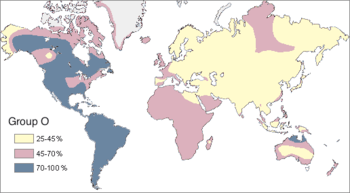
Prior to the 1952 confirmation of DNA as the hereditary material by Alfred Hershey and Martha Chase, scientists used blood proteins to study human genetic variation.[92][93] The ABO blood group system is widely credited to have been discovered by the Austrian Karl Landsteiner, who found three different blood types in 1900.[94] Blood groups are inherited from both parents. The ABO blood type is controlled by a single gene (the ABO gene) with three alleles: i, IA, and IB.[95]
Research by Ludwik and Hanka Herschfeld during World War I found that the frequencies of blood groups A, B and O differed greatly from region to region.[93] The "O" blood type (usually resulting from the absence of both A and B alleles) is very common around the world, with a rate of 63% in all human populations.[96] Type "O" is the primary blood type among the indigenous populations of the Americas, in-particular within Central and South America populations, with a frequency of nearly 100%.[96] In indigenous North American populations the frequency of type "A" ranges from 16% to 82%.[96] This suggests again that the initial Amerindians evolved from an isolated population with a minimal number of individuals.[97][98]
| PEOPLE GROUP | O (%) | A (%) | B (%) | AB (%) |
|---|---|---|---|---|
| Blackfoot Confederacy (N. American Indian) | 17 | 82 | 0 | 1 |
| Bororo (Brazil) | 100 | 0 | 0 | 0 |
| Eskimos (Alaska) | 38 | 44 | 13 | 5 |
| Inuit (Eastern Canada & Greenland) | 54 | 36 | 23 | 8 |
| Hawaiians (Polynesians, non-Amerindian) | 37 | 61 | 2 | 1 |
| Indigenous North Americans (as a whole Native Nations/First Nations) | 79 | 16 | 4 | 1 |
| Maya (modern) | 98 | 1 | 1 | 1 |
| Navajo | 73 | 27 | 0 | 0 |
| Peru | 100 | 0 | 0 | 0 |
See also
| Wikimedia Commons has media related to Genetic studies of indigenous populations of the Americas. |
- Archaeogenetics
- Archaeogenetics of the Near East
- Archaeology of the Americas
- Ancient DNA
- Clovis culture
- Early human migrations
- Genetic history of Africa (disambiguation)
- Genetic history of Europe
- Genetic history of Italy
- Genetic history of North Africa
- Genetic history of the British Isles
- Genetic history of the Iberian Peninsula
- Genetics and archaeogenetics of South Asia
- Human timeline
- Life timeline
- Haplogroups of historical and famous figures
- Nature timeline
- Race and genetics
- Y-chromosome haplogroups in populations of the world
References
- 1 2 3 Wendy Tymchuk, Senior Technical Editor (2008). "Learn about Y-DNA Haplogroup Q. Genebase Tutorials". Genebase Systems. Archived from the original on 2010-06-22. Retrieved 2009-11-21.
- ↑ Orgel, Leslie E. (2004). "Prebiotic chemistry and the origin of the RNA world" (PDF). Critical Reviews in Biochemistry and Molecular Biology. 39 (2): 99–123. CiteSeerX 10.1.1.537.7679. doi:10.1080/10409230490460765. PMID 15217990.
- ↑ Tallbear, Kim (2014). "The Emergence, Politics, and Marketplace of Native American DNA". In Kleinman, Daniel Lee; Moore, Kelly. Routledge Handbook of Science, Technology, and Society. Routledge. p. 23. ISBN 978-1-136-23716-4.
- 1 2 Moreno-Mayar, J. Víctor; Potter, Ben A.; Vinner, Lasse; Steinrücken, Matthias; Rasmussen, Simon; Terhorst, Jonathan; Kamm, John A.; Albrechtsen, Anders; Malaspinas, Anna-Sapfo; Sikora, Martin; Reuther, Joshua D.; Irish, Joel D.; Malhi, Ripan S.; Orlando, Ludovic; Song, Yun S.; Nielsen, Rasmus; Meltzer, David J.; Willerslev, Eske (2018), "Terminal Pleistocene Alaskan genome reveals first founding population of Native Americans", Nature, 553 (7687): 203–207, doi:10.1038/nature25173, PMID 29323294, retrieved January 3, 2018 Confidence intervals given in Moreno-Mayar et al. (2018): 26.1-23-9 kya for the separation of the East Asian lineage of ANA from modern East Asian populations; 25-20 kya for the admixture event of ANE and early East Asian lineages ancestral to ANA; 22.0-18.1 kya for the separation of Ancient Beringian from other Paleo-Indian lineages; 17.5-14.6 kya for the separation of Paleo Indian into North Native Americans (NNA) and South Native Americans (SNA). Supplementary Material p. 37. "the admixture event that gave rise to most Na-Dene-speakers, between NNA and a Siberian population occurred well after 11.5 kya and at least prior to ~2.5 kya".
- ↑ Y Chromosome Consortium (2002). "A Nomenclature System for the Tree of Human Y-Chromosomal Binary Haplogroups" (PDF). Genome Research. 12 (2): 339–348. doi:10.1101/gr.217602. PMC 155271. PMID 11827954. (Detailed hierarchical chart)
- ↑ Griffiths, Anthony J. F.; Miller, Jeffrey H.; Suzuki, David T.; et al., eds. (2000). An Introduction to Genetic Analysis (7th ed.). New York: W.H. Freeman. ISBN 978-0-7167-3771-1.
- 1 2 3 Tamm, Erika; Kivisild, Toomas; Reidla, Maere; et al. (5 September 2007). "Beringian Standstill and Spread of Native American Founders". PLoS One. 2 (9): e829. Bibcode:2007PLoSO...2..829T. doi:10.1371/journal.pone.0000829. PMC 1952074. PMID 17786201.
- ↑ Derenko, Miroslava; Malyarchuk, Boris; Grzybowski, Tomasz; et al. (21 December 2010). "Origin and Post-Glacial Dispersal of Mitochondrial DNA Haplogroups C and D in Northern Asia". PLOS ONE. 5 (12): e15214. Bibcode:2010PLoSO...515214D. doi:10.1371/journal.pone.0015214. PMC 3006427. PMID 21203537.
- 1 2 3 4 5 6 7 8 9 Bortolini, Maria-Catira; Salzano, Francisco M.; Thomas, Mark G.; et al. (September 2003). "Y-chromosome evidence for differing ancient demographic histories in the Americas" (PDF). American Journal of Human Genetics. 73 (3): 524–539. doi:10.1086/377588. PMC 1180678. PMID 12900798.
- 1 2 Ruhlen, Merritt (November 1998). "The origin of the Na-Dene". Proceedings of the National Academy of Sciences of the United States of America. 95 (23): 13994–13996. Bibcode:1998PNAS...9513994R. doi:10.1073/pnas.95.23.13994. PMC 25007. PMID 9811914.
- 1 2 3 4 Zegura, Stephen L.; Karafet, Tatiana M.; Zhivotovsky, Lev A.; Hammer, Michael F. (January 2004). "High-Resolution SNPs and Microsatellite Haplotypes Point to a Single, Recent Entry of Native American Y Chromosomes into the Americas". Molecular Biology and Evolution. 21 (1): 164–175. doi:10.1093/molbev/msh009. PMID 14595095.
- 1 2 3 Saillard, Juliette; Forster, Peter; Lynnerup, Niels; Bandelt, Hans-Jürgen; Nørby, Søren (2000). "mtDNA Variation among Greenland Eskimos. The Edge of the Beringian Expansion" (PDF). American Journal of Human Genetics. 67 (3): 718–726. doi:10.1086/303038. PMC 1287530. PMID 10924403.
- ↑ Schurr, Theodore G. (21 October 2004). "The Peopling of the New World: Perspectives from Molecular Anthropology". Annual Review of Anthropology. 33: 551–583. doi:10.1146/annurev.anthro.33.070203.143932.
- ↑ Torroni, Antonio; Schurr, Theodore G.; Yang, Chi-Chuan; et al. (January 1992). "Native American Mitochondrial DNA Analysis Indicates That the Amerind and the Nadene Populations Were Founded by Two Independent Migrations" (PDF). Genetics. 30 (1): 153–162. PMC 1204788. PMID 1346260.
- ↑ Wade, Nicholas (12 March 2014). "Pause Is Seen in a Continent's Peopling". The New York Times.
- ↑ Lyovin, Anatole V. (1997). "Native Languages of the Americas". An Introduction to the Languages of the World. Oxford University. p. 309. ISBN 978-0-19-508115-2.
- ↑ Mithun, Marianne (October 1990). "Studies of North American Indian Languages". Annual Review of Anthropology. 19 (1): 309–330. doi:10.1146/annurev.an.19.100190.001521. JSTOR 2155968.
- 1 2 3 4 5 Wang, Sijia; Lewis, Cecil M., Jr.; Jakobsson, Mattias; et al. (23 November 2007). "Genetic Variation and Population Structure in Native Americans". PLoS Genetics. 3 (11): e185. doi:10.1371/journal.pgen.0030185. PMC 2082466. PMID 18039031.
- 1 2 3 4 Walsh, Bruce; Redd, Alan; Hammer, Michael F. (30 January 2008). "Joint match probabilities for Y chromosomal and autosomal markers" (PDF). Forensic Science International. 174 (2–3): 234–238. doi:10.1016/j.forsciint.2007.03.014. PMID 17449208. Archived from the original (PDF) on 2010-07-03.
- 1 2 3 4 5 6 7 Wells, Spencer (2002). The Journey of Man: A Genetic Odyssey. Princeton University Press. pp. 138–140. ISBN 978-0-691-11532-0.
- 1 2 Hey, J (2005). "On the Number of New World Founders: A Population Genetic Portrait of the Peopling of the Americas". Hey J: PLoS Biol. 3 (6): e193. doi:10.1371/journal.pbio.0030193. PMC 1131883. PMID 15898833.
- ↑ Wade, Nicholas (2010-02-11). "Ancient Man In Greenland Has Genome Decoded". The New York Times.
- ↑ Rasmussen, Morten; Anzick, Sarah L.; Waters, Michael R.; et al. (2014). "The genome of a Late Pleistocene human from a Clovis burial site in western Montana". Nature. 506 (7487): 225–229. Bibcode:2014Natur.506..225R. doi:10.1038/nature13025. PMC 4878442. PMID 24522598.
- ↑ "Ancient American's genome mapped". BBC News. 2014-02-14.
- 1 2 Reich, David; Patterson, Nick; Campbell, Desmond; et al. (2012). "Reconstructing Native American population history". Nature. 488 (7411): 370–374. Bibcode:2012Natur.488..370R. doi:10.1038/nature11258. PMC 3615710. PMID 22801491. Retrieved 10 November 2015.
- ↑ Dediu, Dan; Levinson, Stephen C. (20 September 2012). "Abstract Profiles of Structural Stability Point to Universal Tendencies, Family-Specific Factors, and Ancient Connections between Languages". PLoS ONE. 7 (9): e45198. Bibcode:2012PLoSO...745198D. doi:10.1371/journal.pone.0045198. PMC 3447929. PMID 23028843.
- ↑ Raghavan; et al. (21 August 2015). "Genomic evidence for the Pleistocene and recent population history of Native Americans" (pdf). Science. 349 (6250): aab3884. doi:10.1126/science.aab3884. PMC 4733658. PMID 26198033. Retrieved 6 October 2015.
- ↑ Skoglund, P; Mallick, S; Bortolini, MC; et al. (21 July 2015). "Genetic evidence for two founding populations of the Americas" (pdf). Nature. 525 (7567): 104–8. Bibcode:2015Natur.525..104S. doi:10.1038/nature14895. PMC 4982469. PMID 26196601. Retrieved 7 October 2015.
- ↑ Skoglund, P.; Reich, D. (2016). "A genomic view of the peopling of the Americas". Current Opinion in Genetics & Development. 41: 27–35. doi:10.1016/j.gde.2016.06.016. PMC 5161672. PMID 27507099.
- ↑ Santos, Fabrício R.; Pandya, Arpita; Tyler-Smith, Chris; et al. (February 1999). "The Central Siberian Origin for Native American Y Chromosomes". American Journal of Human Genetics. 64 (2): 619–628. doi:10.1086/302242. PMC 1377773. PMID 9973301.
- ↑ Blanco Verea; Alejandro José. Linajes del cromosoma Y humano: aplicaciones genético-poblacionales y forenses. Univ Santiago de Compostela. pp. 135–. GGKEY:JCW0ASCR364. Retrieved 2011-06-15.
- 1 2 "How the Subclades of Y-DNA Haplogroup Q are determined". Genebase Systems. 2009. Retrieved 2009-11-22.
- ↑ "Y-DNA Haplogroup Tree". Genebase Systems. 2009. Retrieved 2009-11-21.
- 1 2 3 4 "Frequency Distribution of Y-DNA Haplogroup Q1a3a-M3". GeneTree. 2010. Archived from the original on 2009-11-04. Retrieved 2010-01-30.
- ↑ "Learning Center :: Genebase Tutorials". Genebase.com. 1964-10-22. Archived from the original on 17 November 2013.
- ↑ Bonatto, SL; Salzano, FM (4 March 1997). "A single and early migration for the peopling of the Americas supported by mitochondrial DNA sequence data". Proceedings of the National Academy of Sciences of the United States of America. 94 (5): 1866–1871. Bibcode:1997PNAS...94.1866B. doi:10.1073/pnas.94.5.1866. PMC 20009. PMID 9050871.
- ↑ Smolenyak, Megan; Turner, Ann (2004). Trace Your Roots with DNA: Using Genetic Tests to Explore Your Family Tree. Rodale. p. 83. ISBN 978-1-59486-006-5.
- ↑ Than, Ker (14 February 2008). "New World Settlers Took 20,000-Year Pit Stop". National Geographic News.
- ↑ Lovgren, Stefan (2 February 2007). "First Americans Arrived Recently, Settled Pacific Coast, DNA Study Says". National Geographic News.
- ↑ "First Americans Endured 20,000-Year Layover – Jennifer Viegas, Discovery News". 2017-05-10. Archived from the original on 2012-10-10. Retrieved 2009-11-18. page 2 Archived March 13, 2012, at the Wayback Machine.
- 1 2 3 4 Malhi, Ripan Singh; Gonzalez-Oliver, Angelica; Schroeder, Kari Britt; et al. (10 July 2008). "Distribution of Y Chromosomes Among Native North Americans: A Study of Athapaskan Population History". American Journal of Physical Anthropology. 137 (4): 412–424. doi:10.1002/ajpa.20883. PMC 2584155. PMID 18618732.
- ↑ González Burchard, Esteban; Borrell, Luisa N.; Choudhry, Shweta; et al. (December 2005). "Latino Populations: A Unique Opportunity for the Study of Race, Genetics, and Social Environment in Epidemiological Research". American Journal of Public Health. 95 (12): 2161–2168. doi:10.2105/AJPH.2005.068668. PMC 1449501. PMID 16257940.
- ↑ Lell, Jeffrey T.; Sukernik, Rem I.; Starikovskaya, Yelena B.; et al. (2002). "The Dual Origin and Siberian Affinities of Native American". The American Journal of Human Genetics. 70 (1): 192–206. doi:10.1086/338457. PMC 384887. PMID 11731934.
- 1 2 3 Raghavan, Maanasa; Skoglund, Pontus; Graf, Kelly E.; et al. (2014). "Upper Palaeolithic Siberian genome reveals dual ancestry of Native Americans". Nature. 505 (7481): 87–91. Bibcode:2014Natur.505...87R. doi:10.1038/nature12736. PMC 4105016. PMID 24256729.
- ↑ Michael Balter (October 2013). "Ancient DNA Links Native Americans With Europe". Science. 342 (6157): 409–410. Bibcode:2013Sci...342..409B. doi:10.1126/science.342.6157.409. PMID 24159019.
- ↑ Xue, Yali; Zerjal, Tatiana; Bao, Weidong; et al. (1 April 2006). "Male Demography in East Asia: a North-South Contrast in Human Population Expansion Times". Genetics. 172 (4): 2431–2439. doi:10.1534/genetics.105.054270. PMC 1456369. PMID 16489223.
- ↑ Marinakis, Aliki (2008). "Na-Dene People". In Johansen, Bruce E.; Pritzker, Barry M. Encyclopedia of American Indian History. ABC-CLIO. p. 441. ISBN 978-1-85109-818-7.
- 1 2 Schurr, Theodore G. (May–June 2000). "Mitochondrial DNA and the Peopling of the New World" (PDF). American Scientist Online.
- ↑ Zakharov, Ilia A.; Derenko, Miroslava V.; Maliarchuk, Boris A.; et al. (April 2004). "Mitochondrial DNA variation in the aboriginal populations of the Altai-Baikal region: implications for the genetic history of North Asia and America". Annals of the New York Academy of Sciences. 1011 (1): 21–35. Bibcode:2004NYASA1011...21Z. doi:10.1196/annals.1293.003. PMID 15126280.
- ↑ Starikovskaya, Elena B.; Sukernik, Rem I.; Derbeneva, Olga A.; et al. (7 January 2005). "Mitochondrial DNA diversity in indigenous populations of the southern extent of Siberia, and the origins of Native American haplogroups". Annals of Human Genetics. 69 (1): 67–89. doi:10.1046/j.1529-8817.2003.00127.x. PMC 3905771. PMID 15638829.
- ↑ Ritter, Malcolm (13 March 2008). "Native American DNA Links to Six "Founding Mothers"". National Geographic News. Associated Press.
- 1 2 3 Eshleman, Jason A.; Malhi, Ripan S.; Smith, David Glenn (14 February 2003). "Mitochondrial DNA Studies of Native Americans- Conceptions and Misconceptions of the Population Prehistory of the Americas". Evolutionary Anthropology. 12 (1): 7–18. doi:10.1002/evan.10048.
- 1 2 3 Achilli, Alessandro; Perego, Ugo A.; Bravi, Claudio M.; et al. (12 March 2008). "The Phylogeny of the Four Pan-American MtDNA Haplogroups: Implications for Evolutionary and Disease Studies". PLoS ONE. 3 (3): e1764. Bibcode:2008PLoSO...3.1764A. doi:10.1371/journal.pone.0001764. PMC 2258150. PMID 18335039.
- ↑ Nina G. Jablonski (2002). The first Americans: the Pleistocene colonization of the New World. University of California Press. p. 301. ISBN 978-0-940228-50-4. Retrieved 2011-06-15.
- ↑ "The peopling of the Americas: Genetic ancestry influences health". Scientific American. 14 August 2009 – via Phys.org.
- 1 2 Fagundes, Nelson J.R.; Kanitz, Ricardo; Eckert, Roberta; et al. (3 March 2008). "Mitochondrial Population Genomics Supports a Single Pre-Clovis Origin with a Coastal Route for the Peopling of the Americas". American Journal of Human Genetics. 82 (3): 583–592. doi:10.1016/j.ajhg.2007.11.013. PMC 2427228. PMID 18313026.
- ↑ Meltzer, David J. (2009). First Peoples in a New World: Colonizing Ice Age America. University of California Press. p. 162. ISBN 978-0-520-94315-5.
- ↑ "An mtDNA view of the peopling of the world by Homo sapiens". Cambridge DNA. 2009. Archived from the original on 2011-05-11. Retrieved 2010-04-29.
- ↑ Reidla, Maere; Kivisild, Toomas; Metspalu, Ene; et al. (November 2003). "Origin and Diffusion of mtDNA Haplogroup X". American Journal of Human Genetics. 73 (5): 1178–1190. doi:10.1086/379380. PMC 1180497. PMID 14574647.
- ↑ "An mtDNA view of the peopling of the world by Homo sapiens". Cambridge DNA Services. 2007. Archived from the original on 2011-05-11. Retrieved 2011-06-01.
- 1 2 Robert E. Ferrell; Ranajit Chakraborty; Henry Gershowitz; W. S. Laughlin; W. J. Schull (1990). "The St. Lawrence Island Eskimos, Genetic Variation and Genetic Distance". American Journal of Physical Anthropology. 55 (3): 351–8. doi:10.1002/ajpa.1330550309. PMID 6455922.
- 1 2 Helgason, Agnar; Pálsson, Gísli; Pedersen, Henning Sloth; et al. (2006). "mtDNA variation in Inuit populations of Greenland and Canada: migration history". American Journal of Physical Anthropology. 130 (1): 123–134. doi:10.1002/ajpa.20313. PMID 16353217.
- ↑ Raghavan, M; Skoglund, P; Graf, KE; et al. (January 2014). "Upper Palaeolithic Siberian genome reveals dual ancestry of Native Americans". Nature. 505 (7481): 87–91. Bibcode:2014Natur.505...87R. doi:10.1038/nature12736. PMC 4105016. PMID 24256729. Lay summary – ScienceDaily.
- ↑ "Ancient Siberian Genome Reveals Genetic Origins of Native Americans". PHYSORG. Nov 20, 2013. Retrieved 2013-11-23.
- ↑ Kashani, Baharak Hooshiar; Ugo A. Perego1, Anna Olivieri, Norman Angerhofer, Francesca Gandini, Valeria Carossa, Hovirag Lancioni, Ornella Semino, Scott R. Woodward, Alessandro Achilli, Antonio Torroni (January 2012). "Mitochondrial haplogroup C4c: A rare lineage entering America through the ice-free corridor?". American Journal of Physical Anthropology. 147 (1): 35–39. doi:10.1002/ajpa.21614. PMID 22024980.
- ↑ "Ancient mitochondrial DNA provides high-resolution time scale of the peopling of the Americas, 2016" (PDF).
- ↑ González-José, R. et al., "Craniometric evidence for Palaeoamerican survival in Baja California", Nature vol. 425 (2003), 62–65.
- ↑ Weber, George (2007). Fuegian and Patagonian Genetics and the settling of the Americas. Andaman Association. Archived from the original on 2013-05-05. Retrieved 2010-01-22.
García-Bour J, Pérez-Pérez A, Alvarez S, et al. (April 2004). "Early population differentiation in extinct aborigines from Tierra del Fuego-Patagonia: ancient mtDNA sequences and Y-chromosome STR characterization". Am. J. Phys. Anthropol. 123 (4): 361–70. doi:10.1002/ajpa.10337. PMID 15022364. Neves W.A., Powell J.F., Ozolins E.G. 1999, "Extra-Continental Morphological Affinities of Palli Aike, Southern Chile", Intersciencia, 24/4: 258- 263. - ↑ Bonatto, Sandro L.; Salzano, Francisco M. (1997). "A single and early migration for the peopling of the Americas supported by mitochondrial DNA sequence data". Proceedings of the National Academy of Sciences. 94 (5): 1866–1871. doi:10.1073/pnas.94.5.1866. PMC 20009. PMID 9050871.
- ↑ P. Skoglund, D. Reich, "A genomic view of the peopling of the Americas", Curr Opin Genet Dev. 2016 Dec; 41: 27–35, doi: 10.1016/j.gde.2016.06.016. "Recently, we carried out a stringent test of the null hypothesis of a single founding population of Central and South Americans using genome-wide data from diverse Native Americans. We detected a statistically clear signal linking Native Americans in the Amazonian region of Brazil to present-day Australo-Melanesians and Andaman Islanders (‘Australasians’). Specifically, we found that Australasians share significantly more genetic variants with some Amazonian populations—including ones speaking Tupi languages—than they do with other Native Americans. We called this putative ancient Native American lineage "Population Y" after Ypykuéra, which means ‘ancestor’ in the Tupi language family."
- ↑ Cinq-Mars J. (1979). "Bluefish Cave 1: A Late Pleistocene Eastern Beringian Cave Deposit in the Northern Yukon". Canadian Journal of Archaeology (3): 1–32.
- ↑ Bonnichsen, Robson, Critical arguments for Pleistocene artifacts from the Old Crow basin, Yukon: a preliminary statement (p.102-118), in Bryan, Alan L., editor Early Man in America from a Circum-Pacific Perspective. Edmonton: Archaeological Researches International (Occasional Papers No. 1), Department of Anthropology, University of Alberta, 1978
- ↑ Dillehay, Tom D.; Ocampo, Carlos (November 18, 2015). "New Archaeological Evidence for an Early Human Presence at Monte Verde, Chile". PLoS ONE. 10 (11): e0141923. doi:10.1371/journal.pone.0141923.
- ↑ Bourgeon, Lauriane; Burke, Ariane; Higham, Thomas (2017-01-06). "Earliest Human Presence in North America Dated to the Last Glacial Maximum: New Radiocarbon Dates from Bluefish Caves, Canada". PLOS ONE. 12 (1): e0169486. doi:10.1371/journal.pone.0169486. ISSN 1932-6203. PMC 5218561. PMID 28060931.
- ↑ Gilbert, M. Thomas P.; Jenkins, Dennis L.; Götherstrom, Anders; Naveran, Nuria; Sanchez, Juan J.; Hofreiter, Michael; Thomsen, Philip Francis; Binladen, Jonas; Higham, Thomas F. G. (2008-05-09). "DNA from Pre-Clovis Human Coprolites in Oregon, North America". Science. 320 (5877): 786–789. doi:10.1126/science.1154116. ISSN 0036-8075. PMID 18388261.
- ↑ Newman, Richard (1999). "Miscegenation". In Kwame Appiah and Henry Louis Gates, Jr. Africana: The Encyclopedia of the African and African American Experience (1st ed.). New York: Basic Civitas Books. p. 1320. ISBN 978-0-465-00071-5.
Miscegenation, a term for sexual relations across racial lines; no longer in use because of its racist implications
- ↑ Chasteen, John Charles; Wood, James A (2004). Problems in modern Latin American history, sources and interpretations. Sr Books. pp. 4–10. ISBN 978-0-8420-5060-9. Retrieved 2010-02-24.
- ↑ Chasteen (2004:4): "between the White elite and the mass of Amerindians and Negroes there existed by 1700 a thin stratum of population subject neither to Negro slavery nor Amerindian tutelage, consisting of the products of racial interbreeding among Whites, Amerindians, and Negroes and defined as mestizos, mulattoes and zambos (mixture of Indian and Negro) and their many combinations."
- ↑ "Admixture Studies in Latin America: From the 20th to the 21st Century" (PDF). Facultad de Humanidades y Ciencias de la Educación. 2000. Retrieved 2010-02-24.
- ↑ Sweet, Frank W (2004). "Afro-European Genetic Admixture in the United States". Essays on the Color Line and the One-Drop Rule. Backintyme Essays. Retrieved 2010-02-24.
- ↑ Sweet, Frank W (2005). Legal History of the Color Line: The Notion of Invisible Blackness. Backintyme Publishing. p. 542. ISBN 978-0-939479-23-8. Retrieved 2010-02-24.
- ↑ Soong, Roland (1999). "Racial Classifications in Latin America". Latin American Media. Retrieved 2010-02-25.
- ↑ Brehaut, Harry B (1998). "The Red River Cart and Trails: The Fur Trade". Manitoba Historical Society. Retrieved 2010-02-24.
- ↑ "Who are Métis ?". Métis National Council. 2001. Archived from the original on 2010-02-26. Retrieved 2010-02-24.
- ↑ Adams, Paul (July 10, 2011). "Blood affects US Indian identity". BBC News. Retrieved October 22, 2017 – via www.bbc.com.
- ↑ Bureau, U.S. Census. "American FactFinder - Results". factfinder.census.gov. Retrieved October 22, 2017.
- ↑ "Why Do So Many People Claim They Have Cherokee In Their Blood? - Nerve". www.nerve.com. Retrieved October 22, 2017. Smithers, Gregory D. (October 1, 2015). "Why Do So Many Americans Think They Have Cherokee Blood?". Slate. Retrieved October 22, 2017 – via Slate.
- ↑ "The Cherokee Syndrome - Daily Yonder". www.dailyyonder.com. Retrieved October 22, 2017.
- 1 2 Hitt, Jack (August 21, 2005). "The Newest Indians". The New York Times. Retrieved October 22, 2017 – via www.nytimes.com.
- ↑ Nieves, Evelyn (March 3, 2007). "Putting to a Vote the Question 'Who Is Cherokee?'". The New York Times. Retrieved October 22, 2017 – via www.nytimes.com. . Principal Chief of the Cherokee Nation, Bill John Baker, reported as of "1/32 Cherokee" ancestry (which would amount to about 3%).
- ↑ "What Percentage Indian Do You Have to Be in Order to Be a Member of a Tribe or Nation? - Indian Country Media Network". indiancountrymedianetwork.com. Retrieved October 22, 2017. . "Disappearing Indians, Part II: The Hypocrisy of Race In Deciding Who's Enrolled - Indian Country Media Network". indiancountrymedianetwork.com. Retrieved October 22, 2017.
- ↑ Hershey A, Chase M (1952). "Independent functions of viral protein and nucleic acid in growth of bacteriophage" (PDF). J Gen Physiol. 36 (1): 39–56. doi:10.1085/jgp.36.1.39. PMC 2147348. PMID 12981234.
- 1 2 LILLE-SZYSZKOWICZ I (1957). "Development of studies on pleiades of blood groups". Postȩpy Higieny I Medycyny Doświadczalnej. 11 (3): 229–33. PMID 13505351.
- ↑ Landsteiner K (1900). "Zur Kenntnis der antifermentativen, lytischen und agglutinierenden Wirkungen des Blutserums und der Lymphe". Zentralblatt Bakteriologie. 27: 357–62.
- ↑ Yazer M, Olsson M, Palcic M (2006). "The cis-AB blood group phenotype: fundamental lessons in glycobiology". Transfus Med Rev. 20 (3): 207–17. doi:10.1016/j.tmrv.2006.03.002. PMID 16787828.
- 1 2 3 "Distribution of Blood Types". Behavioral Sciences Department, Palomar College. 2010. Archived from the original on 2006-02-21. Retrieved 2010-03-14.
- ↑ Estrada-Mena B, Estrada FJ, Ulloa-Arvizu R, et al. (May 2010). "Blood group O alleles in Native Americans: implications in the peopling of the Americas". Am. J. Phys. Anthropol. 142 (1): 85–94. doi:10.1002/ajpa.21204. PMID 19862808.
- ↑ Chown, B; Lewis, M (2005). "The blood group genes of the Cree Indians and the Eskimos of the ungava district of Canada". American Journal of Physical Anthropology. 14 (2): 215–224. doi:10.1002/ajpa.1330140217. PMID 13362488.
- ↑ "Racial and Ethnic Distribution of ABO Blood Types". BloodBook. 2008. Retrieved 2010-03-31.
Further reading
- Peter N. Jones (October 2002). American Indian mtDNA, Y chromosome genetic data, and the peopling of North America. Bauu Institute. ISBN 978-0-9721349-1-0.
- Joseph Frederick Powell (2005). The first Americans: race, evolution, and the origin of Native Americans. Cambridge University Press. ISBN 978-0-521-82350-0.
- Francisco M. Salzano; Maria Cátira Bortolini (2002). The evolution and genetics of Latin American populations. Cambridge University Press. ISBN 978-0-521-65275-9.
- "The peopling of the Americas: Genetic ancestry influences health". scientific journal American Journal of Physical Anthropology. University of Oklahoma. 2009. Retrieved 2009-11-21.
.svg.png)
